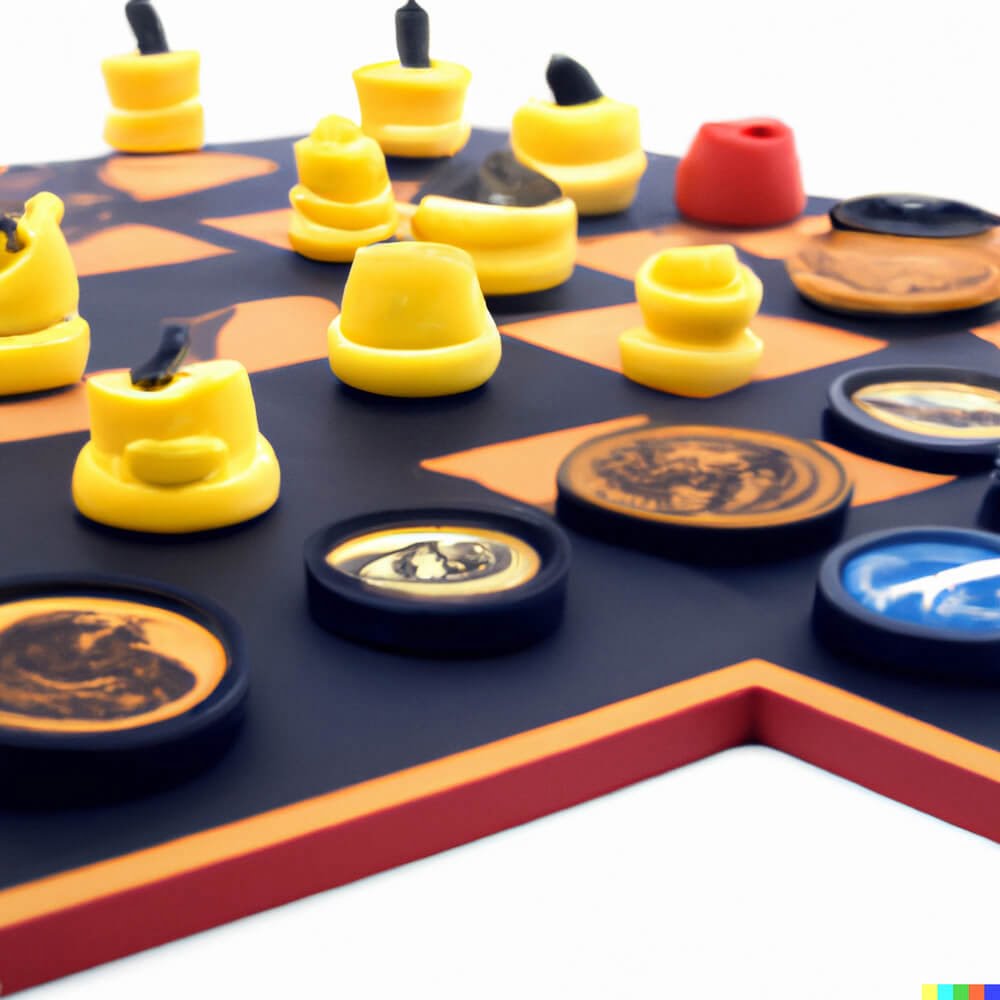The 1960’s classic Chutes and Ladders board game holds a special place in the hearts of many, evoking feelings of nostalgia and fond memories. This beloved game has been entertaining both children and adults for decades, standing the test of time with its timeless charm.
In this article, we will delve into the fascinating history behind this iconic board game, explore its gameplay mechanics, reminisce about the golden era of board games through Chutes and Ladders, and examine its enduring appeal.
Chutes and Ladders originated in ancient India as a game called “Snakes and Ladders,” but it wasn’t until the 1940s that it made its way to British and American shores. Milton Bradley introduced Chutes and Ladders to American audiences in 1943, with a design that featured vibrant illustrations depicting various scenarios that players encountered along their journey towards victory. The game gained popularity during the 1960s when it reflected the cultural shifts happening at the time.
The simplicity of Chutes and Ladders’ gameplay mechanics is part of what makes it so endearing. Players roll a dice or spin a spinner to determine how many spaces they can move on the board. As they progress, they encounter chutes or ladders that either propel them forward or set them back.
The objective is to reach the final square first by navigating these ups and downs effectively. Beyond just being an entertaining pastime, Chutes and Ladders also secretly enhances children’s skills by teaching them about numbers, counting, patience, turn-taking, decision-making, and perseverance.
Join us on a journey through time as we explore the origins, artistry, variations, educational benefits, evolution over the decades, modern adaptations, and lasting appeal of this quintessential classic board game. Whether you are a fan from childhood or new to the world of Chutes and Ladders altogether, prepare to embark on an adventure filled with fun-filled memories and a deeper appreciation for this timeless symbol of entertainment.
The Origin Story
The origins of the 1960’s Classic Chutes and Ladders board game trace back to ancient India. Known as Snakes and Ladders, it was played on a square board with numbered squares connected by ladders and snakes. The objective was to reach the last square first by climbing up ladders and avoiding sliding down snakes. This game was not only a popular pastime but also had moral and spiritual significance, with ladders representing virtues while snakes symbolized vices.
In the late 19th century, Snakes and Ladders made its way to England where it gained popularity among children. It wasn’t until Milton Bradley, an American game manufacturer, decided to rebrand the game in 1943 that it became known as Chutes and Ladders. The design of the board was modified, replacing snakes with chutes or slides.
Chutes and Ladders gained widespread recognition in the 1960s when it was released as a board game. Its simple gameplay and easy-to-understand mechanics appealed to children, making it a staple in homes across America. The game retained the basic concept of Snakes and Ladders but included vibrant illustrations that brought each slide and ladder to life. These illustrations added to the charm of the game, captivating players young and old.
Key Points
- Snakes and Ladders originated in ancient India.
- Milton Bradley rebranded the game as Chutes and Ladders in 1943.
- The 1960’s version of Chutes and Ladders featured vibrant illustrations that brought the game to life.
The Origin Story section provides insights into how this beloved game came into existence. From its origins in ancient India to its rebranding by Milton Bradley, readers gain an understanding of how Chutes and Ladders evolved over time. Additionally, highlighting the vibrant illustrations is important as they were instrumental in capturing players’ imaginations during their gameplay experience.
By delving into the origin story, readers can appreciate the historical significance of the 1960’s Classic Chutes and Ladders board game and understand how it has become a cherished part of popular culture.
The Gameplay Mechanics
The gameplay mechanics of the 1960’s Classic Chutes and Ladders Board Game are simple yet engaging, adding to its enduring popularity. This section will take a closer look at the rules and objectives that have shaped countless enjoyable game nights for families and friends.
- The objective: The main goal of Chutes and Ladders is to be the first player to reach the top square on the game board. Each player takes turns rolling a single die and moving their token along the numbered spaces on the board. The first player to land exactly on square number 100 wins the game.
- Movement: Players advance their tokens forward by counting out the number rolled on the dice. They move from square to square, following a predetermined path that connects all 100 squares. For added excitement, players can encounter chutes or ladders along their journey, which either elevate them closer to their goal or send them sliding back down.
- Chutes and ladders: One of the most distinctive features of this classic board game is its chutes (slides) and ladders (stairs). When a player lands on a numbered square directly at the bottom of a ladder, they get to move their token up to the corresponding higher-numbered square at the top of that ladder, significantly advancing their progress towards victory.
Conversely, when players land on a numbered square directly above a chute, they must slide down to the corresponding lower-numbered square at the bottom of that chute. - Teaching life lessons: While seemingly simple on surface level, Chutes and Ladders teaches valuable life lessons such as good sportsmanship and understanding consequences for one’s actions. The element of chance in rolling dice also helps children develop decision-making skills as they strategize and weigh risks during gameplay.
Nostalgia Unleashed
Chutes and Ladders, a classic board game that originated in the 1960s, holds a special place in the hearts of many who grew up during this golden era of board games. This beloved game has become a symbol of nostalgia, taking players on a journey back to a time when family entertainment centered around gathering around the dining room table for an evening of fun.
The popularity of Chutes and Ladders during the 1960s can be attributed to its simple yet captivating gameplay mechanics. The objective of the game is to navigate your way from start to finish by spinning a spinner and moving your playing piece along numbered squares.
However, what truly sets Chutes and Ladders apart is the presence of chutes (slides) which can send you backwards and ladders that give you a boost forward. This element of chance mixed with the thrill of sliding down chutes or climbing up ladders creates an exciting experience for players of all ages.
One aspect that makes Chutes and Ladders so memorable is its timeless appeal. During the 1960s, board games were often one of the primary sources of entertainment for families. With no access to smartphones or tablets, families would gather together to play games like Chutes and Ladders, creating cherished memories in the process. The simplicity and accessibility of Chutes and Ladders made it a favorite choice among households during this period.
| Year | Number of Copies Sold (in millions) |
|---|---|
| 1960 | 1.5 |
| 1961 | 2.3 |
| 1962 | 2.8 |
| 1963 | 3.4 |
| 1964 | 4.1 |
These sales figures show a steady increase in demand for Chutes and Ladders during the 1960s, highlighting its widespread popularity and cultural significance during this golden era of board games. It is evident that Chutes and Ladders captured the imagination of players across the nation, solidifying its place as an iconic game that remains deeply ingrained in our memories and hearts to this day.
Iconic Artwork and Design
Colorful Illustrations that Sparked Imagination
One of the most captivating aspects of the 1960’s Classic Chutes and Ladders Board Game is its vibrant artwork and design. The illustrations featured on the game board and cards are truly timeless, captivating players of all ages with their vivid colors and whimsical scenes.
The game board itself is a visual delight, featuring a winding path that takes players through a series of chutes and ladders. Each square on the board is adorned with beautiful illustrations depicting various scenarios, such as children playing in a park, animals frolicking in nature, or families enjoying picnics. The charming imagery adds an element of wonderment to the game, making it visually appealing for both children and adults alike.
An Invitation to Explore
The illustrations in Chutes and Ladders serve more than just an aesthetic purpose; they actually play a crucial role in the gameplay experience. As players move their game pieces along the board, the artworks invite them to immerse themselves in different storylines and scenarios. The visuals provide opportunities for imaginative play, allowing players to create their own narratives as they progress through the game.
Moreover, these illustrations also serve as effective teaching tools. For younger players who may not understand numerical concepts yet, the pictures guide them on how to move their pieces forward or backward depending on what they land on. By using visual cues rather than relying solely on numbers, the artwork helps foster early cognitive development by reinforcing basic counting skills.
A Timeless Aesthetic
The iconic artwork of Chutes and Ladders has stood the test of time, continuing to resonate with players even decades after its initial release. Its appeal lies not only in its nostalgic charm but also in its ability to evoke a sense of joy and wonderment that transcends generations.
Whether played on the original 1960’s edition or on modern-day adaptations, the vibrant illustrations of Chutes and Ladders continue to captivate players, making it a beloved classic that will forever hold a special place in the hearts of board game enthusiasts.
Chutes and Ladders vs. Snakes and Ladders
Chutes and Ladders, known as Snakes and Ladders in some parts of the world, has become a global phenomenon that has entertained people for generations. This classic board game has not only captured the hearts of children in the 1960s but also continues to be enjoyed by players of all ages today. In this section, we will delve into the origins of Snakes and Ladders and how it differs from Chutes and Ladders.
The Origins of Snakes and Ladders
The roots of Snakes and Ladders can be traced back to ancient India, where it was known as Moksha Patam, or the “Path to Salvation.” The game was played on a rectangular board with numbered squares along a path depicting virtues like faith, reliability, generosity, and others. Players would roll dice or spin a wheel to determine their moves.
The goal was to navigate the path by climbing up ladders (representing virtues) and avoid sliding down snakes (symbolizing vices). The first player to reach the final square was believed to achieve spiritual liberation.
The Transformation into Chutes and Ladders
When Snakes and Ladders made its way to England in the late 19th century, it underwent some changes in its transformation into Chutes and Ladders. While the basic objective remained the same – reaching the final square – chutes or slides were introduced instead of snakes. The concept of virtues was replaced with lessons about good behavior, hence aligning more with educational values suitable for young children.
Today, both versions of the game coexist across different countries. In North America, Chutes and Ladders is widely recognized as an iconic childhood game, while many other regions continue to refer to it as Snakes and Ladders. Despite these regional differences, the essence of climbing ladders and avoiding slips remains constant throughout all variations.
By understanding the global phenomenon and variations of Chutes and Ladders, we gain a deeper appreciation for how this classic game transcends cultural boundaries and continues to bring joy to people all around the world. Its simplicity, coupled with valuable life lessons and strategic thinking, has contributed to its enduring popularity over the years.
The Educational Benefits
Chutes and Ladders, the iconic 1960’s classic board game, is not only a source of entertainment for children, but also a tool that can enhance their skills in various areas. This section will delve into the educational benefits of playing Chutes and Ladders and how it can contribute to a child’s development.
One of the main skills that children can develop while playing Chutes and Ladders is counting and number recognition. The game requires players to move their tokens forward on the board based on the number rolled on the dice. This constant exposure to numbers helps children become more comfortable with counting and recognizing numbers, which is a fundamental skill in mathematics.
In addition to counting, Chutes and Ladders also promotes basic math skills such as addition and subtraction. When players land on a ladder, they get to climb up spaces on the board, while landing on a chute brings them down. These actions involve adding or subtracting the number indicated by the ladder or chute, allowing children to practice basic arithmetic operations in a fun and engaging way.
Moreover, Chutes and Ladders encourages strategic thinking and decision-making. Players must decide whether they should take risks and aim for ladders or play it safe by avoiding chutes. This element of decision-making enhances critical thinking skills as children learn to assess different outcomes and make choices based on probability.
| Educational Benefits | Description |
|---|---|
| Counting and Number Recognition | Players constantly encounter numbers while playing the game, improving their counting and number recognition skills. |
| Basic Math Skills | Landing on ladders or chutes involves adding or subtracting numbers, allowing children to practice basic arithmetic operations. |
| Strategic Thinking and Decision-Making | Players must assess different outcomes and make strategic decisions, enhancing their critical thinking skills. |
Chutes and Ladders Through the Decades
Chutes and Ladders, also known as Snakes and Ladders in some parts of the world, has truly stood the test of time. As one of the most beloved board games of all time, it has seen numerous iterations and adaptations over the decades since its original release in the 1960s. This section will delve into the fascinating evolution of Chutes and Ladders, exploring how it has managed to maintain its enduring appeal through the years.
Since its inception, Chutes and Ladders has undergone several changes to adapt to new generations and preferences. The game has seen different themes, from traditional versions featuring ladders representing virtues and snakes representing vices, to editions featuring popular characters such as Dora the Explorer or Disney princesses. These themed versions have helped keep the game relevant and appealing to different age groups.
Another key factor in Chutes and Ladders’ evolution is its adaptation into digital formats. With technology advancing rapidly, many classic board games have made their way onto online platforms or mobile applications. Chutes and Ladders is no exception. Digital adaptations of the game offer a convenient way for players to enjoy it without needing physical components or opponents present.
Despite these changes, what truly keeps Chutes and Ladders captivating throughout the decades is its simple yet engaging gameplay mechanics. The game’s blend of luck and strategy appeals to both children and adults alike. It offers a balance between chance (rolling dice) and decision-making (choosing which path to take), making each playthrough exciting and unpredictable.
Modern-Day Adaptations
In the digital age, board games have taken on a new form with the advent of digital versions and updated editions. The 1960’s Classic Chutes and Ladders Board Game is no exception to this modern-day trend. As technology continues to advance, game developers have found innovative ways to bring this beloved game to life in digital format.
Digital versions of Chutes and Ladders offer a whole new level of convenience and accessibility. Players can now enjoy the game on various electronic devices such as smartphones, tablets, and computers. This means that the fun of Chutes and Ladders can be carried anywhere, whether it’s on a long car ride or during a family vacation. Additionally, these digital adaptations often come with interactive features like animations, sound effects, and even multiplayer modes, enhancing the overall gaming experience.
Updated editions of the classic Chutes and Ladders board game have also made their way into homes around the world. These editions feature revamped artwork and design, incorporating modern aesthetics while still maintaining the nostalgic charm of the original game. Some updated versions even come with additional gameplay elements or variations, providing new challenges for players who are already familiar with the base game.
While some may argue that traditional board games should remain as physical tabletop experiences, there is no denying the allure of digital adaptations and updated editions. The convenience and enhanced features offered by these modern interpretations bring Chutes and Ladders into the 21st century without detracting from its timeless appeal. Whether playing digitally or with an updated edition, one thing remains certain: the thrill of climbing ladders and sliding down chutes will continue to captivate generations to come.
Conclusion
The 1960’s Classic Chutes and Ladders Board Game has undoubtedly left a lasting impact on generations around the world. As we have seen throughout this exploration of its origin, gameplay mechanics, nostalgic allure, iconic artwork, educational benefits, and modern-day adaptations, this beloved game has managed to stand the test of time.
One of the key reasons why the 1960’s Classic Chutes and Ladders Board Game continues to thrill generations is its simple yet engaging gameplay. The rules and objectives are easy to understand, making it accessible to players of all ages. The element of chance creates excitement and suspense with every roll of the dice, making each playthrough a unique experience.
Furthermore, the educational benefits hidden within this classic game have contributed to its enduring appeal. Through its gameplay, children learn important skills such as counting, number recognition, taking turns, and problem-solving. The game promotes strategic thinking as players navigate through various chutes and ladders in their pursuit of reaching the final square.
In conclusion, the 1960’s Classic Chutes and Ladders Board Game remains a treasured pastime for families across generations. Its timeless charm can be attributed to its simple yet captivating gameplay mechanics, the nostalgia it evokes from a golden era of board games, iconic artwork that still captivates players today, educational benefits for children’s development, and even modern-day adaptations that cater to digital platforms.
This remarkable game has certainly stood the test of time and will continue to bring joy and entertainment for many more years to come.

I love playing all kinds of games – from classics like Monopoly to modern favourites like Ticket to Ride.
I created this blog as a way to share my love of board games with others, and provide information on the latest releases and news in the industry.





